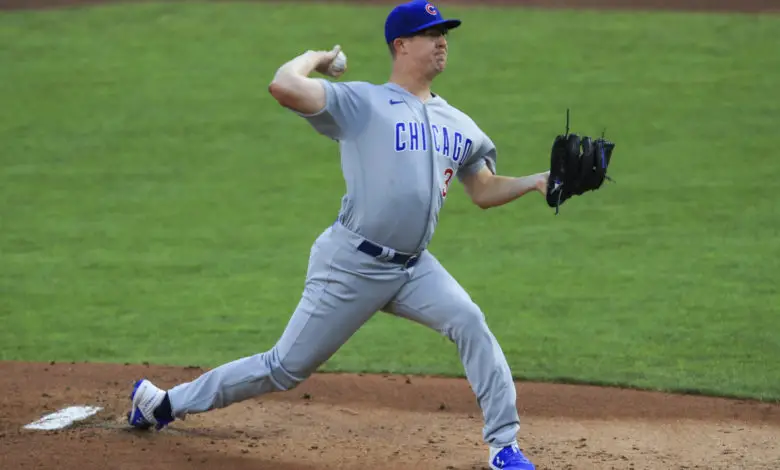
Alec Mills Slowing Curve as He Runs with Opportunity to Prove He Belongs
Alec Mills isn’t a guy you’d pick out of a lineup when asked to identify a major league starting pitcher, nor does his career minor league stat line point to his emergence as a dude. Sure, the 3.69 ERA is nice, but a 32-39 record and 1.22 WHIP over 143 appearances is just kind of meh. Then you look at his pigeon-toed landing (see featured image) and think there’s no way this guy can sling it effectively.
But something seems to change when he pitches at the highest level.
Though he’s now got the same 3.69 ERA in the 63.1 MLB innings as he had in the minors, Mills has struck out 72 batters (10.23 K/9) and held opponents to a .203 average. That’s two more strikeouts per nine innings and 52 points lower on the average, which doesn’t really make sense when you’re talking about a guy who throws around 90 mph and didn’t put up big K numbers even in the lower reaches of the minors.
It would be easy to chalk the disparities up to small sample flukes, but Mills knows that’s not the case. A cerebral pitcher with an impressive repertoire that continues to evolve, the advanced information at his disposal with the Cubs provides a big performance boost.
“I think it’s a combination of everything,” Mills told CI back in March. “One thing the Cubs do well is the scouting department — as far as attacking hitters’ weaknesses or maybe just things that they’re not as good at — is very, very advanced and helped me a lot when I got up. I started really sitting down with [Mike] Borzello and Tommy [Hottovy] and Brad Mills, I was able to really dive into hitters and really start to exploit weaknesses with certain pitches.”
A grip change last year in Iowa allowed him to really differentiate his curveball, both from his slider and from every other bender in the league. Since he really started dialing it down, Mills’ 67.6 mph curve was the slowest such pitch in MLB last season in terms of average velocity. Just look how far to the left it is of the the MLB standard.

“Coming up, my curveball and slider had always been similar pitches — both velocity and movement — and I was having trouble making them two distinct pitches‘ Mills said. “So it was one of those things where I started messing with it with the pitching coach down at Triple-A, slowing the curveball down and varying the grip.
“I had a little bit of success in the bullpen, saw some differences. And it was one of those things where it was like, ‘Well, you know what? Let’s throw it in a game and see what happens.’ And it had some success and then I’ve been gradually able to slow it down more and more.”
Alec Mills threw 17 pitches 69 mph or slower in Tuesday's outing.
All 17 were curveballs, with the slowest clocking in at 64.9 mph.
— Tony Andracki (@TonyAndracki23) July 29, 2020
Sure enough, he was indeed able to ratchet it down even further in Cincinnati. All 17 of the curveballs he threw in his first win as a starting pitcher — his other career W also came against Cincy, but as a reliever — were thrown 69 mph or less, with the slowest coming in at just 64.9 mph. That equated to a 67.2 mph average, well below even last season’s mark.
I have my biases, but this might be the nicest pitch in baseball.
What say you, @Cubs?pic.twitter.com/2WQ0dnSfTq
— Funky Cold Luda (Taylor’s Version) (@lcm1986) July 28, 2020
It’s important to note that Mills isn’t throwing the curve as an out pitch, but to change hitters’ eye levels and set up his other stuff. Though he earned a few whiffs with it Tuesday, showing the slow hook enables him to get Ks with all of his other offerings. To wit, Mills struck out no one on the curve in his first start and notched only one strikeout with it last season.
The extent to which he’s mixed his other pitches to get strike three is uncannily balanced, which is another reason Mills is so effective. According to Statcast, the 44 non-curve strikeouts he’s registered since 2019 are split almost identically between his four-seam (11), sinker (11), changeup (12), and slider (10). Hitters don’t know what’s coming and can’t sit on a certain pitch as a result.
That kind of varied repertoire and having the confidence to throw any of his pitches with two strikes is what makes Mills a legitimate option even if the initial eye test says otherwise. Now he’s out to prove to the Cubs and everyone else that he’s more than just a temporary fill-in for the injured José Quintana, who is scheduled to throw a bullpen Wednesday as he rehabs from surgery to repair nerve damage to his left thumb.
“In my heart, I always felt like I belonged,” Alec Mills said after Tuesday’s win, the second of his MLB career. “It was just a matter of them giving me the job. Me earning it and them giving it to me. Obviously what happened with Q is unfortunate, but I just want to take this and run with it and make them make the tough decision.”

